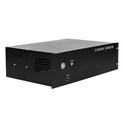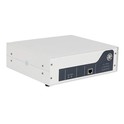As a supplier of ultrasonic transducers, I am often asked about the various applications of our products. One question that frequently comes up is whether an ultrasonic transducer can be used for flow measurement. In this blog post, I will delve into this topic, exploring the principles, advantages, limitations, and practical applications of using ultrasonic transducers for flow measurement.
How Ultrasonic Transducers Work in Flow Measurement
To understand how ultrasonic transducers can be used for flow measurement, it's essential to first grasp the basic principle behind their operation. Ultrasonic transducers are devices that can convert electrical energy into ultrasonic waves and vice versa. When used for flow measurement, they typically operate on one of two main principles: the transit-time difference method and the Doppler effect.
Transit-Time Difference Method
The transit-time difference method is based on the fact that the time it takes for an ultrasonic wave to travel through a fluid is affected by the fluid's flow velocity. In a typical setup, two ultrasonic transducers are installed on opposite sides of a pipe, at a certain angle to the direction of flow. One transducer acts as a transmitter, sending an ultrasonic pulse through the fluid to the other transducer, which acts as a receiver.
When the fluid is flowing, the time taken for the ultrasonic wave to travel downstream (in the direction of flow) is shorter than the time taken to travel upstream (against the direction of flow). By measuring this time difference, the flow velocity of the fluid can be calculated. The volumetric flow rate can then be determined by multiplying the flow velocity by the cross-sectional area of the pipe.
Doppler Effect Method
The Doppler effect method is used primarily for measuring the flow of fluids containing suspended particles or bubbles, such as slurries, wastewater, or blood. In this method, an ultrasonic transducer emits a continuous ultrasonic wave into the fluid. When the ultrasonic wave encounters a moving particle or bubble, it is reflected back to the transducer.
The frequency of the reflected wave is shifted due to the Doppler effect, which is proportional to the velocity of the moving particle or bubble. By analyzing this frequency shift, the flow velocity of the fluid can be determined.
Advantages of Using Ultrasonic Transducers for Flow Measurement
There are several advantages to using ultrasonic transducers for flow measurement, which have made them a popular choice in many industries.
Non-Intrusive Measurement
One of the most significant advantages of ultrasonic flow meters is that they can measure flow rates without being in direct contact with the fluid. This non-intrusive measurement method eliminates the need for cutting into pipes or installing invasive sensors, which can reduce installation costs and minimize the risk of leaks or contamination.
Wide Range of Applications
Ultrasonic transducers can be used to measure the flow of a wide range of fluids, including liquids, gases, and slurries. They are suitable for use in various industries, such as water and wastewater treatment, oil and gas, chemical processing, food and beverage, and pharmaceuticals.
High Accuracy
Modern ultrasonic flow meters can provide high accuracy in flow measurement, typically within ±0.5% to ±2% of the measured value. This accuracy is achieved through advanced signal processing techniques and calibration methods.
Low Maintenance
Ultrasonic flow meters have no moving parts, which means they require minimal maintenance compared to other types of flow meters. This can result in lower operating costs and reduced downtime for maintenance and repairs.
Limitations of Using Ultrasonic Transducers for Flow Measurement
While ultrasonic transducers offer many advantages for flow measurement, they also have some limitations that need to be considered.
Fluid Properties
The accuracy of ultrasonic flow measurement can be affected by the properties of the fluid being measured, such as its density, viscosity, temperature, and the presence of suspended particles or bubbles. For example, in fluids with high viscosity or low acoustic conductivity, the ultrasonic waves may be attenuated or scattered, which can reduce the accuracy of the measurement.
Pipe Conditions
The accuracy of ultrasonic flow measurement can also be affected by the condition of the pipe, such as its diameter, wall thickness, material, and roughness. For example, in pipes with irregular inner surfaces or large diameter variations, the ultrasonic waves may be reflected or refracted, which can cause errors in the measurement.
Installation Requirements
Proper installation of ultrasonic transducers is crucial for accurate flow measurement. The transducers need to be installed at the correct location and angle on the pipe, and the pipe needs to be properly prepared to ensure good acoustic coupling between the transducers and the fluid. Incorrect installation can result in inaccurate measurements or even complete failure of the flow meter.

Practical Applications of Ultrasonic Transducers in Flow Measurement
Despite their limitations, ultrasonic transducers are widely used in various industries for flow measurement. Here are some examples of their practical applications:
Water and Wastewater Treatment
In the water and wastewater treatment industry, ultrasonic flow meters are used to measure the flow rates of water, wastewater, and chemicals. They are used for monitoring and controlling the flow of water in treatment plants, as well as for billing and regulatory compliance.
Oil and Gas
In the oil and gas industry, ultrasonic flow meters are used to measure the flow rates of crude oil, natural gas, and refined products. They are used for custody transfer, production monitoring, and pipeline integrity management.
Chemical Processing
In the chemical processing industry, ultrasonic flow meters are used to measure the flow rates of various chemicals, such as acids, bases, solvents, and polymers. They are used for process control, inventory management, and safety monitoring.
Food and Beverage
In the food and beverage industry, ultrasonic flow meters are used to measure the flow rates of liquids, such as water, milk, juice, and beer. They are used for production monitoring, quality control, and recipe management.
Pharmaceuticals
In the pharmaceutical industry, ultrasonic flow meters are used to measure the flow rates of liquids, such as drugs, vaccines, and biologics. They are used for process control, quality assurance, and regulatory compliance.
Conclusion
In conclusion, ultrasonic transducers can be effectively used for flow measurement in a wide range of applications. Their non-intrusive nature, wide range of applications, high accuracy, and low maintenance make them a popular choice in many industries. However, it's important to consider their limitations and ensure proper installation and calibration to achieve accurate and reliable measurements.
If you are interested in using ultrasonic transducers for flow measurement or have any questions about our products, please feel free to [contact us for procurement and further discussions]. We are a leading supplier of high-quality Ultrasonic Transducers and can provide you with the best solutions for your specific needs.
References
- "Ultrasonic Flow Metering: Principles and Applications," by Peter L. Zanker
- "Flow Measurement Handbook: Industrial Designs and Applications," by Richard W. Miller
- "Measurement, Instrumentation, and Sensors Handbook," edited by John G. Webster





